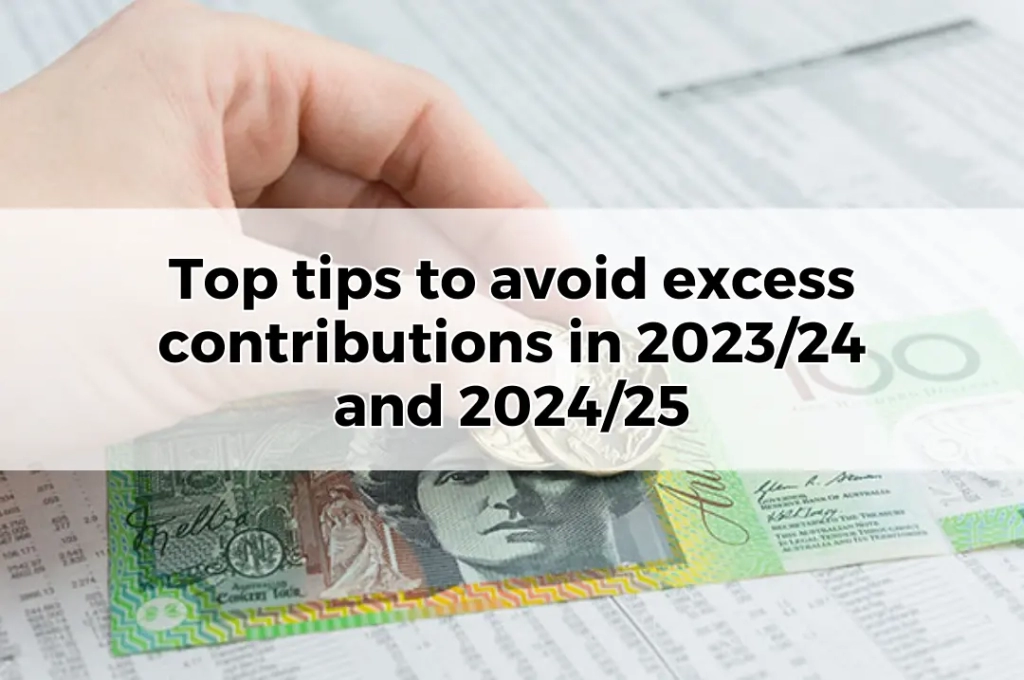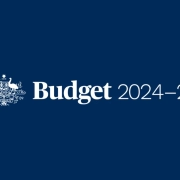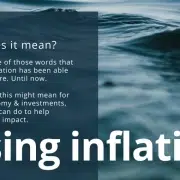Top tips to avoid excess contributions in 2023/24 and 2024/25
Table of Contents
ToggleThis guide explores strategies and potential pitfalls to consider to stay within the super contribution caps for the current and upcoming financial years.
Background
While exceeding super contribution caps might not be as harshly penalised as before, it can still disrupt your retirement savings plan. Breaches can lead to unwanted consequences beyond just tax implications. Additionally, receiving an alert from the ATO about exceeding the cap can be a hassle.
Check myGov – but be cautious
While myGov can be a useful resource to confirm your important information, it’s crucial to be aware of the data’s origin and update frequency.
There can be instances where the information may not be current, necessitating additional measures to guarantee that contribution plans are built on precise and thorough information.
What’s on myGov?
myGov provides details about a client’s:
- concessional contributions (CCs)
- catch-up CCs accrued
- non-concessional contributions (NCCs) including current bring-forward arrangements
- employer contributions
- total super balance (TSB), and
- transfer balance cap (TBC).
How and when myGov data is updated
Keep in mind that the information on myGov relies on what super funds report. This means the details you see might not always be perfectly accurate or up-to-date.
Timing of key fund reporting
The following table explains the timing of super fund reporting and how it could influence your myGov account.
| Data | Reporting timeframe required by fund to ATO | Potential impact on myGov data | |
| APRA Fund | SMSF | ||
| Contributions received | Within 10 business days | In SMSF annual return (SAR) (which may be as late as 5 June) | While data for clients with APRA funds is usually current, there may be a delay for those who have, or had, an SMSF or defined benefit fund during the year. In these cases, contribution information might not accurately reflect actual contributions made after the financial year ended. Personal deductible contributions It's important to remember that the ATO only considers personal contributions towards the CC cap after a client files their tax return and claims a deduction for the contribution. This can lead to situations where myGov might indicate exceeding the cap or triggering a bring-forward period midway through the year. |
| Bring forward NCC information | NCCs are reported within the timeframes above Note: The TSB is a factor in determining eligibility for NCCs. Additionally, using the bring-forward rule may have a delayed application (explained further below). | There's an opportunity for clients to add to their NCCs within an ongoing bring forward period, even if they didn't max out their allowance in previous years. This applies if their TSB as of the previous 30 June falls below the current general transfer balance cap TBC, which is currently $1.9 million. It's important to be cautious in situations where a client's TSB on 30 June is expected to be very close to the TBC cap. This is because TSB information might not be readily available until later in the financial year. Any NCCs made if the client's TSB actually exceeded the TBC on 30 June would be considered excess contributions. |
|
| Catch-up CCs available | While the ATO should update calculations for potential catch-up contributions upon receiving contribution data (as mentioned earlier), this doesn't guarantee eligibility for the individual. One reason is the potential delay in obtaining the client's TSB, especially at the start of the financial year (see details below). | ||
| Total super balance | Up to 31 October | SAR (which may be as late as 5 June) | Information about your TSB might say "as of 30 June," but it might not be accessible until later in the financial year. This is because different funds have different deadlines for submitting this data. |
Other information sources
Account statements
To calculate the TSB at 30 June, we need the exit value, rather than just the closing balance. The exit value represents the amount an investor would receive if they voluntarily left the fund on that date (through options like rollovers or withdrawals). This value may be adjusted to account for specific expenses related to selling assets or any unallocated income.
If your SMSF holds unlisted assets, their value needs to be estimated before you can make informed decisions about how much you can contribute to your fund. This estimate is typically done closer to the end of the financial year (30 June).
It’s important to weigh the pros and cons of waiting to gather more information from the fund’s accountant, administrator, and portfolio valuation reports before making contributions. This might be necessary to make informed decisions. However, there can be situations where delaying contributions isn’t feasible due to deadlines. For instance, if you’re:
- Approaching 67 and won’t qualify for the work test or exemption to make tax-deductible contributions, requiring contributions before reaching 67.
- Nearing 75 and interested in making Roth contributions.
Early planning is crucial in these scenarios to ensure access to the necessary information for contribution recommendations without exceeding limits. The same applies when your account balance nears a relevant (TSB) threshold.
Contact super fund
Early in the financial year, it’s crucial to verify myGov information by directly contacting super funds and documenting your inquiries thoroughly. When contacting them, especially regarding TSB accounts, ensure you get the exit value instead of the 30 June closing balance. Ideally, you should obtain written confirmation from the fund for your records.
myGov data via client
It’s important to remember that financial advisors can’t directly access your myGov information. This means double-checking any verbal financial details you provide them. If you have a registered tax agent, they might be able to view relevant information through the ATO Portal or contact the ATO directly on your behalf (with proper authorisation).
Understand NCC requirements
Before advisors suggest making non-concessional contributions (NCCs), they should consider three key factors:
- Your total superannuation balance (TSB) as of the previous 30 June. This will determine your NCC eligibility for the current year.
- Whether you’re eligible to use the bring-forward rule. This allows exceeding the annual cap by utilising contributions from future years.
- If your contributions span two financial years, an estimate of your TSB for the following year is needed. This ensures you stay within the NCC limits for both years.
Next year, there will be important changes to the TSB threshold for eligibility to make NCCs. Starting from 1 July 2024, the annual and bring-forward NCC caps will increase. However, the general TBC will stay the same at $1.9 million. As a result, TSB thresholds for eligibility will become stricter compared to the previous year (2023/24).
TSB thresholds and maximum NCCs
This table outlines the TSB thresholds and maximum NCCs for the financial years 2023/24 and 2024/25.
| Thresholds and caps in 2023/24 | Thresholds and caps in 2024/25 | ||
|---|---|---|---|
| TSB as at 30/6/23 | NCC cap | TSB as at 30/6/24 | NCC cap |
| $1.9m + | $0 | $1.9m + | $0 |
| $1.79m to < $1.9m | $110,000 | $1.78m to < $1.9m | $120,000 |
| $1.68m to < $1.79m | $220,000 | $1.66m to < $1.78m | $240,000 |
| < $1.68m | $330,000 | < $1.66m | $360,000 |
For example, during the 2023/24 tax year, a client with a TSB below $1.68 million as of 30 June 2023, is eligible to utilise the three-year bring forward rule. However, to qualify for this rule in the following tax year (2024/25), the client’s TSB on 30 June 2024, must be lower than $1.66 million.
To make sure you can implement your preferred strategy for contributions in 2024/25, it’s important for your advisor to estimate your TSB as of 30 June 2024. This will help them ensure you don’t exceed contribution caps. It’s also recommended to have your advisor review your TSB before making any additional contributions in 2024/25 to avoid exceeding contribution caps.
Note: The deadlines for reporting TSB values differ depending on the super fund type. APRA-regulated funds have until 31 October, while Self-Managed Super Funds (SMSFs) report TSB within their annual return, which can be lodged as early as 5 June.
Bring-forward rule triggered
If you qualify, exceeding the annual cap for non-concessional contributions automatically activates bring-forward. This lets you contribute more using the caps from future years, but the total amount and the duration (two or three years) depend on your total super balance on a specific date before the bring-forward starts.
Example 1: Triggering the bring-forward rule
Allison, a 65-year-old woman, had a TSB of $1 million at 30 June 2023. In August of that same year, she made an NCC of $120,000. This triggered the three-year bring-forward rule, which has a maximum contribution cap based on the year it was activated. In Allison’s case, the maximum cap for that year was $330,000. Since her NCC was lower, she can only contribute the remaining amount, or $210,000, over the next two financial years (2024/25 and 2025/26). Unfortunately, this means she won’t benefit from the increased NCC cap that came into effect on 1 July 2024.
People who qualify to make larger super contributions under the bring-forward rule but don’t use the entire amount in the first year can carry the unused portion forward to the second or third year (if eligible). However, there are two key conditions:
- Their TSB on 30 June of the year they want to make the remaining contribution must be less than the general TSB cap (currently $1.9 million).
- The super fund must receive the contribution by 28 days after the end of the month they turn 75 years old.
If a member contributes more than their allowed bring-forward NCC cap (including cases where the NCC cap is zero due to a high previous balance), the excess amount is considered an overcontribution. After the bring-forward period ends, eligible members can contribute again within the yearly limit or re-qualify for the bring-forward based on usual requirements like age and account balance.
Don’t fail downsizer rules
An invalid downsizer contribution may result in an excess NCC.
If a downsizer contribution fails the timing, notification or other eligibility requirements, the contribution is treated as a personal contribution. The fund can only refund a personal contribution received after 28 days following the end of the month when the member has turned 75.
This means in all other circumstances, the contribution is re-reported to the ATO as a personal contribution, and the person may have an excess NCC (depending on their other contributions, available NCC cap and TSB).
Making a downsizer contribution that doesn’t meet the rules can lead to exceeding the NCC.
If the contribution doesn’t meet requirements like timing, notification, or others, it’s treated as a personal contribution. The super fund can only return these contributions if they were made more than 28 days after the end of the month the member turned 75. Otherwise, the contribution gets reported as a personal one to the tax office, and the person might go over their NCC limit (depending on other contributions, their NCC cap, and their Transfer Balance Cap).
Getting a contribution refunded by trustees is very difficult. A failed downsizer contribution can affect a person’s ability to make future contributions under the NCC cap and their overall contribution strategy. However, it’s important to remember that super funds are required to accept personal contributions from anyone under the age of 75. They don’t check a client’s TSB or NCC space before accepting a contribution. Since the TSB was introduced, individuals are responsible for ensuring they meet the eligibility requirements for contributions.
Tread carefully with PDCs
To maximize the benefits of personal deductible contributions (PDCs), it’s crucial to consider all contributions that affect your tax deduction limit throughout the year. This includes:
- Employer contributions: These could be based on a raise, bonus, or other increases in your salary.
- Salary sacrifice contributions: These are explained further in the “Review salary sacrifice arrangements” section below.
- CCs to a defined benefit fund: These are sometimes called “notional taxed contributions.”
Although you can reduce the amount of personal contributions claimed for tax deduction after lodging a notice of intent, it’s crucial to carefully assess the situation. A financial professional can help you decide whether it’s better to adjust the timing of your contributions or the claimed amount to prevent any unintended negative effects. We’ll explore this further in the following section.
Vary or delay personal contribution?
Claiming too many personal contributions as tax deductions can lead to exceeding the CC cap. If this happens after lodging an initial notice, you can adjust the claimed amount (down to zero) to stay within the limit. However, reducing the tax deduction amount creates an NCC which may cause:
- Excess NCC: This occurs if you’ve already used up your NCC allowance for the year.
- Breaching the Annual NCC Cap: This can unintentionally trigger the “bring forward rule” in an unintended year.
Example 2: Variation of notice of intent which triggers the bring forward rule
In 2023/24, Jeric, in his mid-fifties, contributed $115,000 (with a TSB of $1.2 million at 30 June 2023). Initially, he intended to deduct $5,000 of this contribution from his taxes. However, after consulting with his accountant, he amended his claim and ultimately deducted none of the contribution.
Jeric’s unused contribution amount of $115,000 has activated the bring-forward rule for the 2023/24 tax year. This could affect plans if the goal was to use the full annual NCC cap in 2023/24 and defer the bring-forward to 2024/25. Unfortunately, there’s no option to treat the $5,000 exceeding the annual cap as a separate contribution in 2023/24. The bring-forward rule automatically applies once someone qualifies and their contribution surpasses the annual cap.
Time limits and eligibility to vary a notice of intent
Just like the original notice of intent, notices to modify a contribution also have deadlines to be considered valid. Typically, a valid variation notice requires that:
- The notice is submitted before the earlier of two dates: either when the person files their tax return for the year the contribution was made, or by 30 June of the following year, unless the tax office has already rejected the tax deduction for that contribution.
- The contribution remains with the fund.
- No income stream has been started using any of the interest earned on the contribution.
If the Australian Taxation Office (ATO) rejects your claim for a tax deduction and the decision is final, then a contribution tax will have been taken out of your contribution. This amount will still be included in the portion of your super interest that is taxed, and it will also count towards the NCC cap.
Understand work test requirements
People between 67 and 75 can only deduct personal contributions from their taxes if they meet a “work test” or qualify for an exemption. The work test requires working at least 40 hours within a 30-day period during the financial year. It doesn’t have to be done before making the contribution, but it must happen sometime that year for the deduction.
There’s a risk if someone makes a contribution expecting to meet the test later. For instance, imagine a client aged 67-75 who:
- Makes a personal contribution,
- Lodges a notice of intent to claim a deduction, and
- Doesn’t end up meeting the work test due to unforeseen circumstances.
In this case, the client would need to adjust their tax return by filing a variation notice. This would reduce the claimed deduction to zero and affect their NCCs. It’s important to understand situations where this variation might not be accepted (e.g., withdrawing or rolling over the funds).
Review salary sacrifice arrangements
To ensure you stay within your CC cap for salary sacrifice contributions, factor in:
- The rising SG rate to 11.5% starting 1 July 2024 (and 12% from 1 July, 2025), and
- The timing of your salary sacrifice contributions directed towards superannuation.
If you already have a salary sacrifice arrangement, it’s crucial to double-check the agreement and other contribution plans to make sure your CCs stay under the cap.
It’s also important to be aware of when salary sacrifice contributions are considered received. They count towards the contribution cap for the financial year in which the super fund receives them, especially at the beginning and end of the year.
The timing of SG contributions is similar. Employers have until 28 July to make SG payments for the last quarter (April-June) without penalty. However, any contributions received by the super fund on or after 1 July will count towards your CC cap for that financial year.









